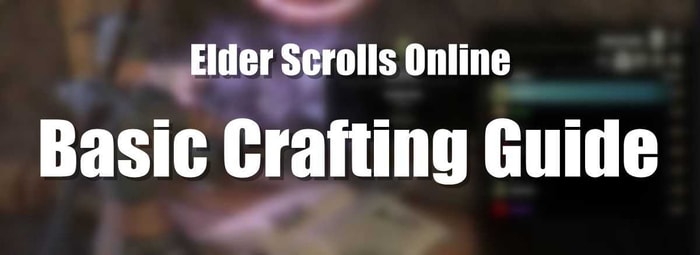Crafting is very useful in The Elder Scrolls Online. With your Crafting skills, you will get rich in ESO by making many valuable things that can be sold for a lot of gold. But the various crafting systems can be extremely confusing when you're starting. Vress Games's video guide helps you understand basic concepts and have enough knowledge to get started.
Crating Skills
In ESO, there are seven crafting skill lines, and you're able to advance every one of them on a single character. The first three come under the category of equipment crafting: Blacksmithing, Woodworking, and Clothier. Each of these skill lines can craft and upgrade particular items that you'll use in-game.
Blacksmiths specialize in melee weapons such as swords, axes, and maces, as well as being able to produce various pieces of heavy armor.
Woodworkers also provide weapons in the form of bows and staves and the ability to craft shields.
Clothier specializes in light and medium armor. If you own the Summerset chapter (expansion in ESO), you'll have access to a fourth equipment crafting line — Jewelry Crafting, which allows you to create or improve rings and necklaces.
The core principles of these four professions are almost the same, and you'll understand why later in this guide. You then have three additional crafting skill lines that are unique in the way that they function.
Firstly, you have Alchemy, which allows you to create potions from various plants, mushrooms, and other reagents that you'll come across in your travels. Alchemists are also able to combine various ingredients in attempts to discover new kinds of potions.
Secondly, you have Enchanting, in which various runes are combined to create glyphs that will give you additional bonuses to weapons, armor, and jewelry.
Finally, there's Provisioning, which involves cooking. As a side note, you can also craft furniture for player housing, and this isn't a skill line in its own right. Instead, it's an extension of all the primary skill lines we've just listed. Each of them allows you to create different items of furniture to place in your home.
Each of the seven crafting skill lines that have been covered can be leveled up by gaining a particular type of experience called inspiration. You gain inspiration by completing various actions in the skill line, such as crafting, deconstructing, or refining items.
Raw Materials
You now know the kind of items you'll be able to craft in ESO. However, to produce any of this, you need to start by gathering resources in the world. The first and most obvious way to gain resources is to collect them as you travel throughout various zones. You'll often come across minerals, wood, plants, mushrooms runes, and many other kinds of harvestable resources. To pick them up, you just need to wander over to them and press "E". There is no prerequisite to gathering resources aside from your level. As you start to reach higher levels, you'll see higher-level resources appear in the world.
If you want to make resource gathering a little easier, you can enhance your gathering ability by spending some skill points. For example, in the Blacksmithing skill line, you can put points into Keen Eye, which will make it easier to identify ore in the world. Or, you could put some points into Miner Hireling, which will provide you with an amount of ore each day. Not all raw materials are born equal. There are tiers, and there are ten tiers of each type of resource. Using Blacksmithing, you have iron ore, steel ore, and others before you hit Rubedite ore at tier 10.
You can also find useful crafting ingredients in containers such as sacks, barrels, and crates. Be warned if the text appears in red because it will be considered stealing if you take anything from that particular container. The consequence of this is that you'll get arrested by the guards and have to pay a fine. One final way you can gain resources is by deconstructing equipment at Crafting Stations, and I'll talk about that later.

Crafting Bag
As your adventure in the world, it always makes sense to pick up as much as possible. This is also where you start to see the first serious limitation of free accounts or to a phrase that the first significant reason to pay the monthly subscription. This is the Crafting Bag, without which you may find yourself playing inventory management on a painfully regular basis. You can expand your inventory through other means, but it's not comparable to the bottomless Crafting Bag you get with ESO Plus. You have to decide what's more valuable to you. The monthly sub cost or the time lost to sort in your inventory.
Now you have a burgeoning bank of resources, and you're looking to start turning them into some of the finest wear Tamriel has to offer.
The first thing you need to do is find a crafting station, and these are available in most major towns and cities. There are crafting stations for each skill line, and each of them gives you a different set of options. Since the basic concepts are pretty much the same for the four equipment crafting professions or skill lines (Blacksmithing, Woodworking, Clothier, and Jewelry Crafting), I will address them, using Blacksmithing as the example.
Refining
For the four equipment crafting lines, you'll be presented with six different tabs when you go to a crafting station. Firstly, you can refine the resources that you collected earlier. This means taking your raw resources and turning them into materials that you need for crafting. The ten tiers of resources can be refined into ten tiers of materials that you can use for crafting. As you'd expect, high-level materials will allow you to produce higher-level Elder Scrolls Online items.
Construction
The next tab allows you to craft stuff. With Blacksmith, you have the option to create melee weapons and heavy armor. You're able to adjust the level of the piece of equipment that you're crafting, and higher levels require more materials. The Style component determines how your armor looks, and the Trait component allows you to give a specific property or effect to that piece of equipment. In this example, I'm crafting armor in the Breton style. However, if I were to use a different material, I could craft the same piece of armor with the same stats but in another style.
Deconstruction
The third tab allows for deconstruction. You're going to pick up a lot of items while questing or exploring dungeons that you don't have a use for. You can destroy a piece of equipment to obtain materials, tempers, tannins, resins, and style and trait components.
Improvement
The tempers, tannins, and resins can then be used in the fourth tab to improve an item's quality in your inventory. I say "in your inventory," as it doesn't have to be the one you crafted yourself.

You can see at the bottom that you have a percentage chance of success based on the number of materials you use to improve the item. As you gain a higher level in a skill line, the materials required to increase your success chance for 100% will become less. Make sure that it's at 100% as it's too heartbreaking if you get to 80% and fail because you will lose all your resources and the item.
Research
The fifth tab, Research, is the most confusing one. With Research, you're able to add particular traits to the items that you craft. One example might be increased regeneration of Stamina, Health, or Magicka, but there are many others, and they're all extremely beneficial.
To apply a trait to a weapon, you need to find a weapon with the trait and research it. Research means to destroy it, so be careful with the item that you choose to research. This takes ages, hours usually, but it can be sped up with certain items, and it also progresses while you're logged out. Once you've researched a particular trait and obtained the necessary materials, you can add that trait to the weapon you craft.
Alchemy
You can create potions at the Alchemy station, using solvents and reagents that you've found during your adventures. To discover different types of potions, you'll have to experiment unless you google it. You need to add one solvent and two reagents. At first, you will get a message telling you either that the reagents will not react or that you will get a potion with an unknown effect. There's no point creating one that won't react, so you need to go for one with unknown effects.
Crafting potions will reveal the properties of the reagents you use. Thus, when you create subsequent potions, you'll be able to specify them rather than just guess. The other thing you can do at the Alchemy station is create poisons, and it works in much the same way, but this time, you get to equip them to enhance your combat abilities.
Enchanting
You're able to combine the runes you found out in the world and create glyphs that will add new properties to your weapons, armor, and jewelry. Different combinations are going to produce different results. As you experiment, you'll start to reveal the properties of different runes, allowing you to create different glyphs.
The second key thing you can do at the Enchanting station is to extract runes, which is the same as deconstructing equipment. You smash up a glyph, and you end up with some runes that you can use to create a new one.
Provisioning
The seventh and final station to cover is Provisioning, which is the most simple of them all. You take a recipe you found during adventures and make sure you learn it by either double-clicking it, or selecting it and pressing "E" in your inventory, then you add the ingredients and press the button.
Writs
There is one more vital piece of information that relates to crafting Writs. These daily crafting quests are worth doing as they'll reward you with rare and valuable crafting materials. To unlock them, you need to complete a handful of quests to get certified. Don't worry. They are very easy and fast to complete. You just need to visit a couple of NPCs in your faction's major city.
Millenith can be found at the Fighters guild, and she'll give you the quest for Blacksmithing, Clothing, and Woodworking. Danel Telleno can be found at the Mages guild, and he'll give you the quest for Enchanting, Alchemy, and Provisioning. For Jewelry Crafting, you'll need to have the Summerset chapter and speak to Felarian in Alinor. They only take a few minutes to do, and once you complete them, you'll become certified in that crafting skill line, and you're able to complete these daily quests known as Writs. To pick these quests up each day, you need to go to an Equipment Crafting Writ noticeboard, and you can easily find them in your faction's major city, close to the crafting stations.
I hope this guide is helpful. If you found this Elder Scrolls Online beginner Crafting guide useful, please share it with your friends and allies in ESO. There is ESO gold for sale on MmoGah, and we use a safe delivery method to make sure your purchase is fast and smooth. Also, please bookmark our ESO news page for more guides in the future.
YOU MAY ALSO LIKE:
ESO Builds: Top 5 Best Builds for Beginners




